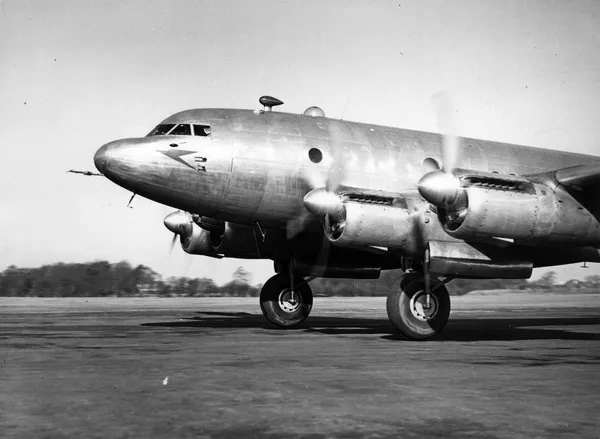Avro Int. Aerospace
Avro Type 688 Tudor
 |
|
| General information | |
|---|---|
| Type | Airliner |
| Manufacturer | Avro |
| Designer | Roy Chadwick |
| Primary users | B.S.A.ABOAC |
| Number built | 38 |
| History | |
| Manufactured | 1945–1949 |
| First flight | 14 June 1945 |
| Developed from | Avro Lincoln |
| Developed into | Avro Ashton |
.
History Avro International Aerospace
Avro Type 688 Tudor
Manufactured 1913–1932
Introduction date 1913, First flight 18 September 1913

The Avro Type 688 Tudor was a British piston-engined airliner based on Avro's four-engine Lincoln bomber, itself a descendant of the famous Lancaster heavy bomber, and was Britain's first pressurised airliner. Customers saw the aircraft as little more than a pressurised DC-4, and few orders were forthcoming, important customers preferring to buy US aircraft. The tailwheel undercarriage layout was also dated and a disadvantage.
Design

The Tudor was a low-wing cantilever monoplane with four engines, a single fin and rudder and a retractable tailwheel undercarriage (in its original configurations).
The wing was of NACA 23018 section at the root, and was a five-piece, all-metal, twin-spar structure. The untapered centre section carried the inboard engines and main undercarriage, while the inner and outer sections were tapered on their leading and trailing edges, with the inner sections carrying the outboard engines. The ailerons were fitted with trim and balance tabs, and there were hydraulically operated split flaps in three sections on each side of the trailing edges of the centre section and inner wings. A 3,300 imp gal (15,000 L; 4,000 US gal) fuel capacity was given by eight bag tanks, one on either side of the fuselage in the centre section and three in both inner wings..
Operational history
Tudor II
The passenger capacity of the Avro 688 was considered unsatisfactory, so a larger version was planned from the outset. Designated the Avro 689 (also Avro XXI), the Tudor II was designed as a 60-seat passenger aircraft for BOAC, with the fuselage lengthened to 105 ft 7 in (32.18 m) compared to the Tudor I's 79 ft 6 in (24.23 m) and the fuselage increased by 1 ft (0.30 m) to 11 ft (3.4 m) diameter, making it the largest UK airliner at the time.
At the end of 1944, while it was still in the design stage, BOAC, Qantas and South African Airways decided to standardise on the Tudor II for Commonwealth air routes, and BOAC increased its initial order for 30 examples to 79.

The prototype Tudor II G-AGSU first flew on 10 March 1946 at Woodford Aerodrome. The changes in design had however resulted in a loss of performance and the aircraft could not be used in hot and high conditions which resulted in Qantas ordering the Constellation and South African Airways, the Douglas DC-4 instead, with the total order reduced to 50.
0
KmCeiling
0
KmCombat RANGE
0
Km/hAircraft Speed
0
Max Crew
Photo Gallery
Avro International Aerospace
Avro Type 688 Tudor
Manufactured 1913–1932 Introduction date 1913 First flight 18 September 1913


Avro Int. Aerospace
Avro Type 688 Tudor Introduction date 1913
First flight 18 September 1913
General Info
-
-
-
- Crew: 5 (two pilots, flight engineer, radio operator, navigator)
- Capacity: 24 passengers
- Length: 79 ft 6 in (24.23 m)
- Wingspan: 120 ft 0 in (36.58 m)
- Height: 22 ft 0 in (6.71 m)
- Wing area: 1,421 sq ft (132.0 m2)
-
-
Powerplant
-
-
- Max takeoff weight: 76,000 lb (34,473 kg)
- Maximum landing weight: 66,000 lb (29,937 kg)
- Powerplant: 4 × Rolls-Royce Merlin 100 V-12 liquid-cooled piston engines, 1,770 hp (1,320 kW) each for take-off
-
Performance
-
- Maximum speed: 290 mph (470 km/h, 250 kn) at 66,000 lb (29,937 kg) at sea level
- Cruise speed: (389 km/h, 210 kn) at 66,000 lb (29,937 kg) at sea level
- Range: (7,500 km, 4,050 nmi) maximum fuel
-
-
-
- 4,100 mi (3,563 nmi; 6,598 km) with maximum payload
-
-
- Maximum range:' 4,890 mi (4,249 nmi; 7,870 km) at 10,000 ft (3,048 m) (engines delivering 500 hp (373 kW))
- Service ceiling: 30,100 ft (9,200 m)
Links to Youtube & Others
Avro began work on the Type 688 Tudor in 1943, following Specification 29/43 for a commercial adaptation of the Lancaster IV bomber, which was later renamed Lincoln. The specification was based on recommendations of the Brabazon Committee, which issued specifications for nine types of commercial aircraft for postwar use.
Avro Int. Aerospace
Avro Type 688 Tudor
The Tudor I was intended for use on the North Atlantic route.
Youtube Link
Two prototypes were ordered in September 1944 and the first, G-AGPF, was assembled by Avro's experimental flight department at Manchester's Ringway Airport














.svg.png)